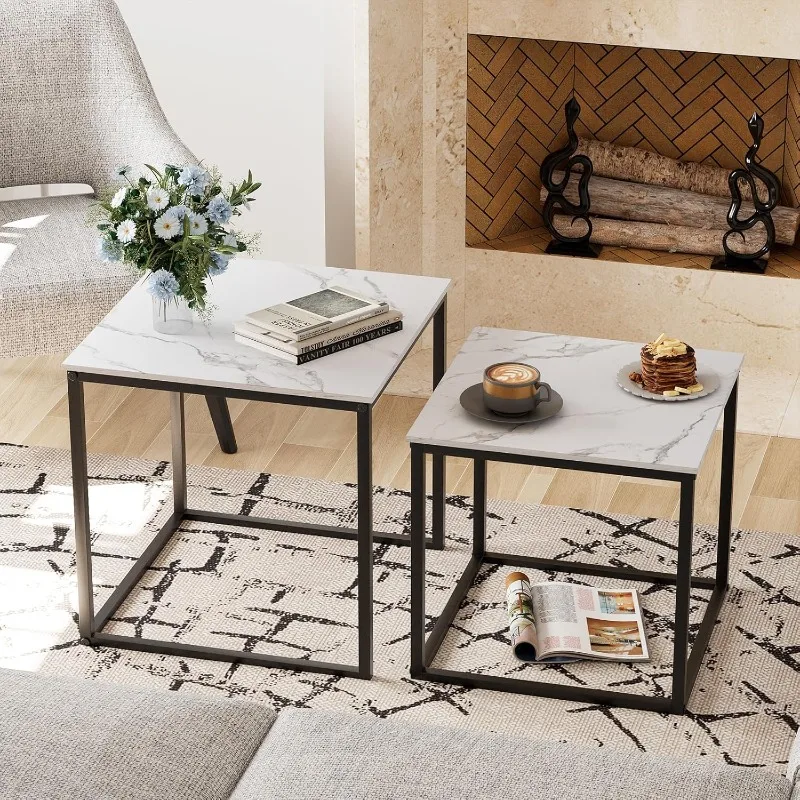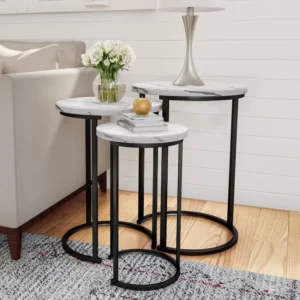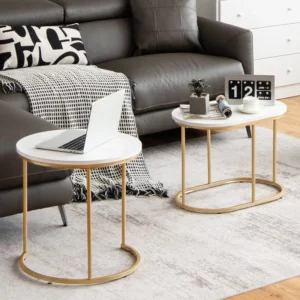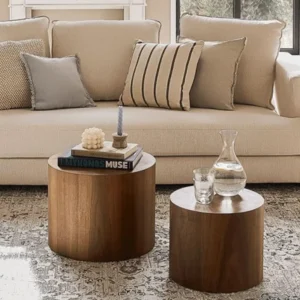Understanding Why Square Tables Work Well for Small Spaces
Square tables are exceptional choices for small rooms, offering efficient use of limited space without compromising on functionality or style. Unlike their rectangular or oval counterparts, square tables maximize every inch of available area through their symmetrical design and versatile placement options.
The benefits of square tables in compact spaces include:
- Perfect symmetry: The equal sides create visual balance and harmony in small rooms
- Corner-friendly: Can be tucked into corners, instantly saving up to 25% more floor space
- Equal access: Provides the same distance between all seated diners, enhancing conversation flow
- Flexible placement: Works well against walls or as a standalone focal point
- Intimate dining: Creates a cozy, connected feeling perfect for small gatherings
Square tables shine particularly in apartments, studio spaces, and compact dining areas where every square foot matters. Their balanced proportions complement the dimensions of smaller rooms without overwhelming the space.
The visual impact of a square table cannot be understated—its clean lines and defined shape bring order to small spaces, creating a sense of intentional design rather than compromise. Many intelligent black mid-century coffee tables demonstrate how these principles work beautifully in practice.
While square tables offer numerous advantages, selecting the appropriate size is crucial for maximizing these benefits. Before choosing a table, it’s important to understand what makes different shapes of coffee tables ideal for small spaces and how to properly measure your available area.
How to Measure Your Space for a Square Table
Properly measuring your space is the critical first step in selecting the right square table. This methodical approach ensures your table fits comfortably while maintaining necessary clearance for movement and comfort.
Follow these steps to accurately assess your space:
- Clear the area: Remove existing furniture from the intended table location
- Measure the total available space: Use a tape measure to determine the length and width of your entire dining area
- Mark walking paths: Identify areas that need to remain clear for foot traffic
- Apply the clearance rule: Allow a minimum of 36 inches (91 cm) of clearance around all sides of where your table will sit
- Calculate maximum table size: Subtract the clearance measurements from your total space dimensions
The golden rule for table clearance is maintaining at least 36 inches (91 cm) of space around all sides. This ensures comfortable seating and easy movement around the table. For tighter spaces, you can reduce this to 24 inches (61 cm) as an absolute minimum, but this will feel cramped.
For example: In a 10×10 ft (3×3 m) room, allowing 36 inches (91 cm) clearance on all sides leaves space for a 48×48 inch (122×122 cm) square table maximum.
Pro tip: Use painter’s tape to outline your potential table area on the floor. This visual guide helps you physically experience how the table will fit before purchasing.
When measuring a room with existing furniture, account for how these pieces affect traffic flow and available space. Consider whether chairs will need to be fully pulled out and pushed back in during use, which requires additional clearance.
Understanding appropriate coffee table sizes for small living rooms can provide additional context for proper proportions and space planning. Once you’ve determined your maximum dimensions, you’ll be better equipped to select from various mid-century modern square coffee tables that fit your specific space constraints.
Perfect Square Table Dimensions for Small Rooms
Finding the ideal square table size for your small room means balancing seating capacity with comfort and space efficiency. The following recommendations provide a comprehensive guide based on the number of people you need to accommodate.
| Number of People | Ideal Table Size | Minimum Room Dimensions |
|---|---|---|
| 2 People | 28-32 inches (71-81 cm) | 8×8 ft (2.4×2.4 m) |
| 4 People | 36-44 inches (91-112 cm) | 9×9 ft (2.7×2.7 m) |
| 6 People (compact) | 48-52 inches (122-132 cm) | 10×10 ft (3×3 m) |
A good rule of thumb is to allow approximately 24 inches (61 cm) of table edge per person for comfortable seating. This ensures everyone has adequate elbow room without feeling cramped.
For intimate settings, a bistro-sized square table of 28-32 inches (71-81 cm) creates a cozy atmosphere while maximizing space efficiency. These smaller tables work beautifully in breakfast nooks, studio apartments, or as supplementary dining surfaces.
Medium-sized square tables (36-44 inches/91-112 cm) represent the sweet spot for most small rooms, comfortably seating four while maintaining a modest footprint. This size works particularly well in dedicated dining areas within apartments or smaller homes.
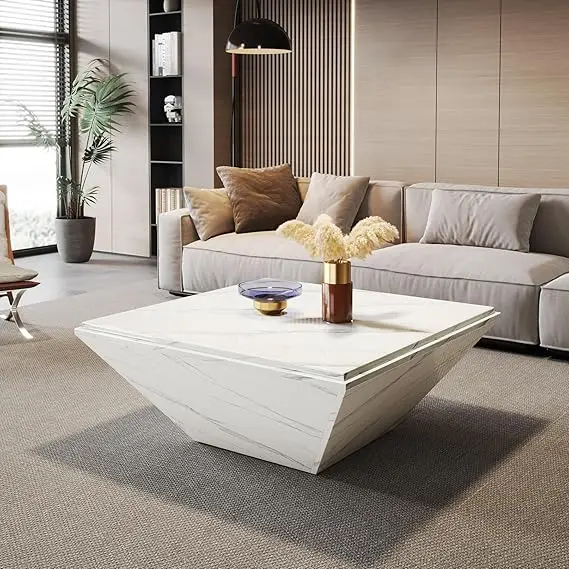
When considering table height, standard dining tables measure 28-30 inches (71-76 cm) tall, which pairs with conventional dining chairs. Counter-height tables (36 inches/91 cm) and bar-height tables (42 inches/107 cm) offer alternative options that can create the illusion of more space in very small rooms.
Our collection of mid-century modern small coffee tables showcases how these dimensions translate into functional, stylish pieces for compact living areas.
Remember that selecting the right size is just the starting point—strategic placement can further enhance the functionality and visual appeal of your square table in a small space.
Smart Placement Strategies That Maximize Small Spaces
How you position your square table can dramatically impact both the functionality and perceived spaciousness of your room. Strategic placement transforms a potentially cramped arrangement into an efficient, welcoming space.
Corner Placement
* Positions the table with two sides against walls
* Saves up to 50% of the clearance space compared to center placement
* Creates a cozy, defined dining nook
* Works best for 2-4 person arrangements
* Ideal for multi-purpose rooms where dining isn’t the primary function
Against-Wall Placement
* Positions one side of the table flush against a wall
* Saves approximately 30% of floor space compared to floating placement
* Perfect for 2-3 person households
* Creates a clear division between dining and living areas
* Allows for decorative wall elements to enhance the dining experience
Floating Placement
* Positions the table centrally in the room
* Creates the most formal dining arrangement
* Requires the most generous clearance (full 36 inches/91 cm on all sides)
* Works best in rooms dedicated primarily to dining
* Establishes the table as a focal point
When working with extremely limited space, consider how table orientation relates to doors, windows, and traffic patterns. Positioning the table to avoid interrupting natural pathways through the room creates a more harmonious flow.
Chair placement deserves equal attention—ensure that chairs can be pulled out comfortably without hitting walls or other furniture. For against-wall placements, consider benches or banquettes that don’t need to be pulled out.
Many homeowners have found success maximizing black mid-century coffee tables through thoughtful placement strategies that complement the table’s design characteristics. The right placement sets the foundation for further space optimization through specialized table features and designs.
Space-Saving Square Table Designs and Features
Beyond size and placement, specific table designs and features can dramatically enhance space efficiency in small rooms. These thoughtful elements can transform a standard square table into a space-saving solution.
Pedestal Base Advantages
* Eliminates corner legs for approximately 20% more leg room
* Allows chairs to tuck completely underneath when not in use
* Creates cleaner visual lines, reducing perceived clutter
* Improves flexibility for seating arrangements
* Simplifies cleaning underneath the table
Drop-Leaf and Extendable Options
* Reduce footprint by up to 50% when partially folded
* Provide flexibility for different gathering sizes
* Allow for different configurations within the same space
* Create multi-functional surfaces that adapt to changing needs
* Maintain the square shape when fully extended
Slender Designs and Visual Lightness
* Thin table tops (¾-1 inch/2-2.5 cm) create less visual bulk
* Hairpin or tapered legs reduce visual weight
* Open framework designs allow light to pass through
* Create the perception of more space through visual transparency
* Complement minimalist aesthetics common in small spaces
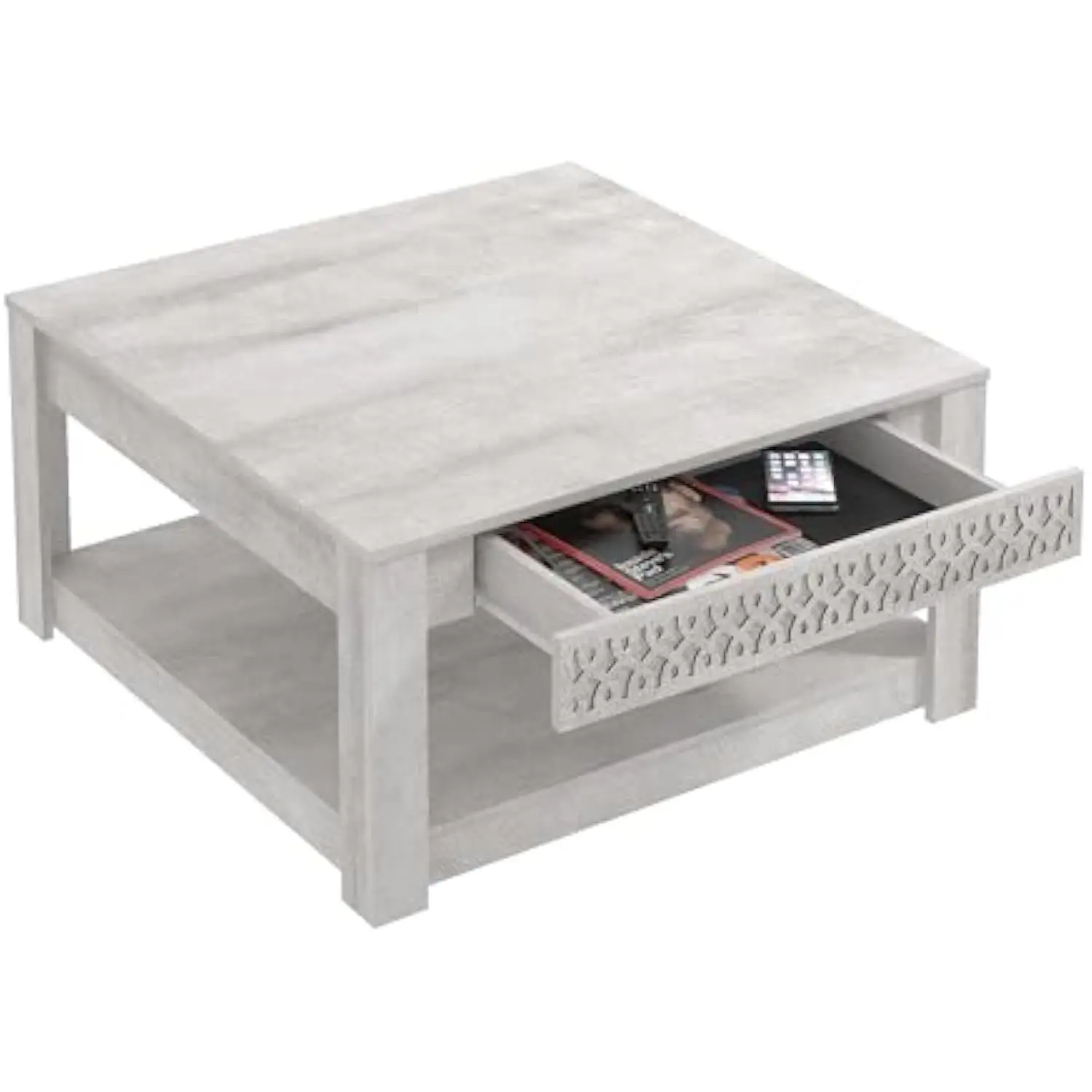
Storage-Integrated Solutions
* Built-in drawers utilize otherwise wasted space
* Under-table shelving provides storage without additional furniture
* Lift-top mechanisms create dual-purpose functionality
* Hidden compartments maintain clean aesthetics while maximizing utility
* Reduce the need for additional storage furniture
For maximum flexibility in variable spaces, consider mid-century modern nesting table sets that can be configured in multiple ways depending on your needs. These adaptable pieces provide exceptional versatility without permanently committing floor space.
Remember that table design directly impacts what chairs will work best with your setup—making chair selection the next crucial consideration for small space dining solutions.
Choosing the Right Chairs for Your Small Space Square Table
Chair selection is equally important as table choice when optimizing small dining areas. The right seating complements your table while maintaining proper clearance and visual harmony.
Space-Efficient Chair Designs
* Armless chairs save 2-3 inches (5-8 cm) of space per seat
* Slim-profile designs minimize footprint without sacrificing comfort
* Stackable options provide flexibility for extra seating when needed
* Low-back chairs create less visual obstruction, enhancing perceived space
* Lightweight construction allows for easy movement as needed
Alternative Seating Options
* Benches accommodate flexible numbers of people and save up to 30% of perimeter space
* Backless stools tuck completely under tables when not in use
* Built-in banquettes eliminate clearance needs on one or more sides
* Floor cushions provide ultra-flexible seating for casual settings
* Folding chairs store away when not needed, freeing up valuable floor space
When selecting chairs, remember that standard dining chairs require approximately 18-24 inches (46-61 cm) of clearance when pushed back. In very tight spaces, consider chairs that can be pulled sideways to exit rather than straight back.
The visual weight of your seating matters as much as its physical dimensions. Open-back chairs, transparent materials, and lighter colors all contribute to a sense of airiness. This principle is demonstrated in many nesting tables and space-saving solutions that pair perfectly with compact seating options.
Chair height should be coordinated with table height for comfort: standard dining chairs (18 inches/46 cm seat height) pair with conventional tables, while counter stools and bar stools are designed for their taller counterparts.
By carefully selecting seating that complements your square table, you create a cohesive dining setup that maximizes both physical space and visual openness.
Visual Design Tricks to Make Your Small Dining Area Feel Larger
Strategic design choices can create the illusion of more space around your square table, making your small dining area feel substantially larger and more inviting.
Material Magic
* Glass tabletops create approximately 30% more visual openness by allowing light to pass through
* Light-colored woods reflect more light, making spaces feel up to 15% larger
* High-gloss finishes bounce light around the room, enhancing brightness
* Mixed materials add interest without overwhelming small spaces
* Transparent elements reduce visual density and create depth
Lighting Enhancements
* Proper overhead lighting can visually expand a space by up to 20%
* Pendant lights draw the eye upward, creating perceived height
* Under-table lighting creates the illusion of floating, adding perceived space
* Dimmable options allow adjustment for different activities and moods
* Directional lighting can highlight table features while minimizing shadows
Mirror Strategies
* Placing mirrors to reflect the table area doubles the perceived space
* Mirrored table bases create floating effects that reduce visual weight
* Reflective surfaces multiply light sources throughout the room
* Strategically placed mirrors can capture and extend views
* Mirrored wall panels behind banquette seating visually double the room
Color Considerations
* Monochromatic schemes create seamless visual flow
* Light neutral tones for table and chairs blend with surroundings
* Color coordination between table, chairs, and room creates cohesion
* Contrasting table base in a darker tone creates visual interest without bulk
* Matching table color to wall color reduces visual interruption
Minimalist tabletop styling further enhances spaciousness—avoid cluttering your table with unnecessary items when not in use. When decorating, select fewer, more impactful pieces rather than numerous small items.
Our mid-century modern glass top coffee tables exemplify how material choices can dramatically affect the visual impact of furniture in small spaces.
Materials and Styles for Small Space Square Tables
The materials and style of your square table significantly impact both its functionality and visual presence in a small room. Each material offers distinct advantages for compact spaces.
Wood Options
* Light woods (maple, ash, birch) reflect up to 30% more light than darker varieties
* Medium-toned woods (cherry, walnut) provide warmth without visual heaviness
* Engineered woods offer stability with reduced weight and cost
* Reclaimed wood adds character and sustainability to small spaces
* Bamboo provides hardwood durability with eco-friendly benefits
Glass Advantages
* Creates visual transparency that makes spaces feel larger
* Tempered glass offers 4-5 times more strength than regular glass
* Frosted or textured options hide smudges and fingerprints
* Combines beautifully with wood, metal, or stone bases
* Easy to clean and maintain in high-use settings
Metal Elements
* Metal frames typically occupy 40-60% less visual space than solid wood legs
* Provides sturdy support with minimal bulk
* Available in various finishes to complement any décor
* Offers contemporary appeal that works in modern small spaces
* Resistant to damage and easy to maintain
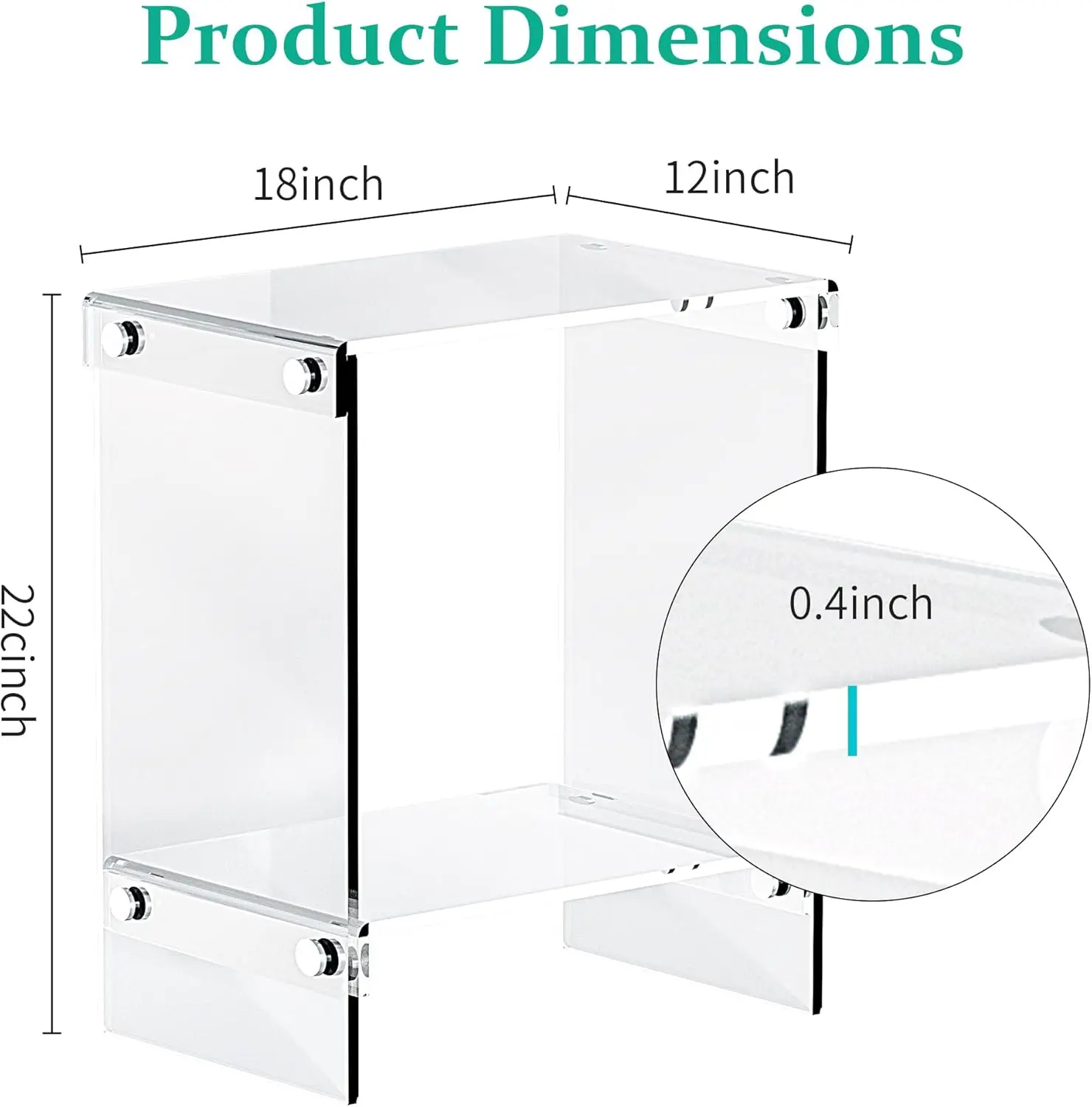
Stone and Composite Surfaces
* Marble, granite, or quartz add luxury in small doses
* Heat and scratch resistance ideal for dual-purpose use
* Available in thin profiles to reduce visual weight
* Composite options offer natural look with improved durability
* Create striking focal points that elevate simple spaces
When selecting styles for small spaces, mid-century modern designs often work exceptionally well due to their emphasis on clean lines, tapered legs, and efficient proportions. Contemporary minimalist styles similarly prioritize function and visual lightness.
Finish options significantly impact how your table interacts with the space—matte finishes reduce glare but may show fingerprints, while semi-gloss finishes balance reflectivity with practicality. The principles of styling black mid-century coffee tables apply equally well to dining tables in creating cohesive, balanced spaces.
The right material and style choice should balance aesthetic preferences with practical considerations of maintenance, durability, and visual impact in your specific space.
Potential Considerations and Limitations of Square Tables
While square tables offer many advantages for small spaces, they come with certain considerations that should be factored into your decision-making process.
Safety Considerations
* Sharp corners can be hazardous in tight spaces with high traffic
* Corner guards or rounded corner options reduce injury risk
* Tables with beveled edges offer a safety compromise
* Heavier tables provide stability but limit rearrangement flexibility
* Glass tops require special cleaning products to maintain clarity
Seating Limitations
* Square tables are least efficient for groups larger than their designed capacity
* Adding extra chairs at corners creates awkward seating arrangements
* Expanding beyond four people typically requires a larger room than comparable rectangular options
* Fixed-size square tables lack the flexibility of extendable rectangular models
* Diagonal seating arrangements waste table surface area
Space Efficiency Challenges
* Rounded corners can save approximately 2 inches (5 cm) of space at each corner but reduce usable surface area
* Perfect squares may not optimize irregular room shapes
* Fixed square tables can’t adjust to accommodate occasional larger gatherings
* Square tables with thick aprons limit leg room in very tight spaces
* Center pedestal bases offer better space efficiency but may limit table size due to stability concerns
When considering alternatives, round tables often work better for very small spaces or rooms with circular traffic patterns, while rectangular tables better accommodate variable group sizes. The design principles discussed in black mid-century coffee table design resources can help inform your decision-making process.
Despite these considerations, square tables remain excellent options for small spaces when properly sized and positioned. The next section provides a practical checklist to guide your final selection.
Quick Decision Guide: Square Table Selection Checklist
Use this practical checklist to ensure you select the perfect square table for your small space:
□ Room measurements completed
* Maximum table size calculated: _____ inches/cm square
* Minimum clearance (36 inches/91 cm ideal) verified on all sides
□ Seating requirements identified
* Number of regular diners: _
* Maximum occasional seating needed:
* Chair dimensions accounted for: __ inches/cm depth when pulled out
□ Table dimensions optimized
* Table size selected: _ inches/cm square
* Table height appropriate for intended use: ___ inches/cm
* Scale proportionate to room size and other furniture
□ Design features prioritized
* Base type selected (four legs, pedestal, trestle)
* Space-saving features identified (extendable, drop-leaf, storage)
* Corner design chosen (sharp, rounded, beveled)
□ Material and style selected
* Material appropriate for usage level and maintenance capacity
* Style compatible with existing décor
* Visual weight suitable for space (heavier/lighter)
□ Budget and longevity considered
* Investment aligns with expected usage duration
* Construction quality sufficient for intended use
* Versatility for potential future spaces
□ Placement strategy determined
* Optimal position in room identified (corner, wall, floating)
* Traffic flow patterns accommodated
* Relationship to other furniture harmonious
Many homeowners find lift-top coffee tables for small spaces provide valuable insights on multi-functionality that apply equally well to dining tables in compact areas.
Frequently Asked Questions About Square Tables for Small Spaces
What is the smallest practical square table for two people?
The minimum functional size for two people is 24×24 inches (61×61 cm), though 28-30 inches (71-76 cm) provides more comfortable dining. For extremely tight spaces, 24-inch tables can work for casual dining or coffee service, but may feel cramped for full meals.
Can a square table work in a rectangular room?
Yes, square tables can work excellently in rectangular rooms, especially when placed against a wall or in a corner. The key is ensuring proper clearance on all accessible sides. Square tables can actually help break up the linearity of a rectangular room, adding visual interest.
How much should I expect to pay for a quality small square table?
Quality small square tables typically range from $150-$800 depending on materials, construction, and design complexity. Solid wood options generally start around $300, while glass-top or mixed-material designs vary widely. Investment pieces with premium materials or designer pedigrees can exceed $1,000.
Are square tables good for apartments and studios?
Square tables are ideal for apartments and studios due to their versatility and efficient footprint. Their ability to tuck into corners or against walls makes them particularly valuable in multi-purpose spaces where dining is just one of many activities the room must accommodate.
How can I make my square table multi-functional?
Select height-appropriate tables that can serve as work surfaces, game tables, or craft stations. Consider models with storage drawers, adjustable heights, or extendable surfaces. Using chair styles that work in multiple contexts (dining, desk, accent) further enhances versatility.
Do square tables take up more or less space than round tables?
For the same seating capacity, square tables typically use space more efficiently than round tables. A round table seating four requires more overall floor space than a square table seating four, though round tables eliminate corner hazards and may feel less cramped when pushed into tight spots.
What’s the best finish for a small space square table?
Light to medium finishes generally work best in small spaces as they reflect more light. For maximum visual lightness, glass tops or high-gloss white finishes create an airy feel. The specific key features of black mid-century coffee tables can provide additional guidance on selecting finishes that balance visual impact with space constraints.
Transforming Your Small Dining Area: Real-World Examples
These real-world examples demonstrate how thoughtfully selected square tables can revolutionize small dining areas:
Studio Apartment Transformation
* Before: A 400 sq ft (37 sq m) studio with no defined dining area and meals eaten on the sofa
* Solution: 30-inch (76 cm) square pedestal table positioned against a wall with lightweight chairs that fully tuck underneath
* Result: Created a functional dining area that doubles as a workspace without sacrificing precious floor space
* Key decision: Choosing a pedestal base eliminated leg obstructions, allowing for flexible seating arrangements
Urban Apartment Corner Optimization
* Before: Awkward empty corner in a 600 sq ft (56 sq m) apartment dining area
* Solution: 36-inch (91 cm) square table with rounded corners placed diagonally in the corner with banquette seating on two sides
* Result: Comfortable seating for four in a space previously thought too small for proper dining
* Key decision: Using built-in bench seating eliminated the need for clearance on two sides
Tiny House Dining Innovation
* Before: 250 sq ft (23 sq m) tiny house with no dedicated dining space
* Solution: 24-inch (61 cm) wall-mounted drop-leaf square table that folds flat when not in use
* Result: Created dining space for two that completely disappears when needed for other activities
* Key decision: Selecting a fold-down model that maintains zero footprint when not in use
Mid-Century Modern Nesting Side & End Tables, Mid-Century Modern Nesting Table Sets, Mid-Century Modern Round Side & End Tables
Price range: $239.35 through $273.06 Select options This product has multiple variants. The options may be chosen on the product pageMid-Century Modern Glass Top Coffee Tables, Mid-Century Modern Glass Top Side & End Tables
$460.58 Select options This product has multiple variants. The options may be chosen on the product pageMid-Century Modern Glass Top Coffee Tables, Mid-Century Modern Vintage Coffee Tables, Mid-Century Modern Vintage Side & End Tables
$725.36 Select options This product has multiple variants. The options may be chosen on the product pageMid-Century Modern Lift Top Coffee Tables, Mid-Century Modern Square Coffee Tables
$454.73 Select options This product has multiple variants. The options may be chosen on the product pageMid-Century Modern Nesting Coffee Tables, Mid-Century Modern Nesting Table Sets
$361.45 Select options This product has multiple variants. The options may be chosen on the product pageMid-Century Modern Nesting Table Sets, Mid-Century Modern Round Coffee Tables
$462.57 Select options This product has multiple variants. The options may be chosen on the product page
These successful implementations demonstrate principles found in perfect harmony square tables for modular living, showing how smart choices can maximize functionality even in the most challenging spaces.
Beyond Dining: Multi-Purpose Square Tables for Small Spaces
In small spaces, furniture must often perform multiple roles. Square tables excel in this versatility, offering functionality beyond just dining.
Workspace Applications
* Counter-height (36 inch/91 cm) square tables make excellent impromptu home offices
* Equal depth on all sides provides consistent workspace regardless of orientation
* Central positioning allows multiple people to collaborate comfortably
* Smooth, stable surfaces support writing, computing, and creative projects
* Square proportions naturally accommodate standard paper and laptop dimensions
Entertainment and Leisure Uses
* Perfect geometry for board games and card playing
* Comfortable reach distance from all sides for shared activities
* Ideal proportions for puzzles and crafting projects
* Functions well for serving refreshments during gatherings
* Creates natural conversation groupings for social interaction
Accessory Enhancements for Multi-Purpose Use
* Drawers or shelves for storing work supplies or dining linens
* Adjustable-height mechanisms to transition between dining and coffee table heights
* Protective mats or overlays to accommodate different activities
* Fold-down wall tables provide 100% space efficiency when not in use
* Casters for mobility when functions change throughout the day
Storage Solutions
* Under-table baskets for quick access to frequently used items
* Built-in compartments for placemats, napkins, or office supplies
* Hollow pedestal bases with hidden storage capacity
* Combination table/shelving units that serve multiple storage needs
* Multi-tier designs that maximize vertical space utilization
The principles used when decorating black mid-century coffee tables apply equally to styling multi-purpose square tables—focus on accessories that enhance functionality while maintaining clean lines and visual simplicity.
At Hearth Forms, we understand that small space living doesn’t mean compromising on style or functionality. Our curated collections feature tables that embody the perfect balance of form and function for today’s compact living environments.

